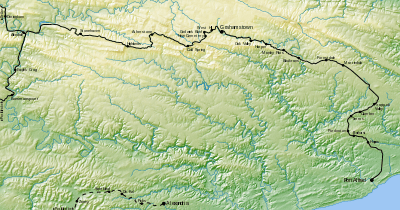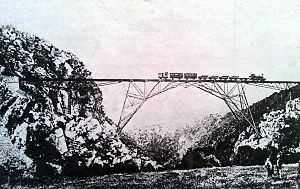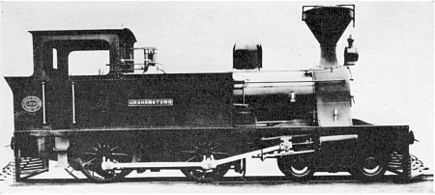Kowie Railway 4-4-0T
| Kowie Railway 4-4-0T | |
|---|---|
|
Kowie Railway 4-4-0T "Grahamstown" | |
| Type and origin | |
| Power type | Steam |
| Designer | Hunslet Engine Company |
| Builder | Hunslet Engine Company |
| Serial number | 294-295 |
| Build date | 1882 |
| Total produced | 2 |
| Specifications | |
| Configuration | 4-4-0T "American" |
| Gauge | 3 ft 6 in (1,067 mm) Cape gauge |
| Leading wheel diameter | 27 1⁄2 in (699 mm) |
| Driver diameter | 48 in (1,220 mm) |
| Wheelbase |
7 ft 3 in (2.210 m) coupled 18 ft 5 in (5.613 m) engine |
| Length | 29 ft 10 in (9.093 m) over couplers |
| Height | 12 ft 2 in (3.708 m) |
| Locomotive weight | 27 long tons (27.4 t) w/o |
| Fuel type | Wood |
| Fuel capacity | 1 1⁄2 long tons (1.5 t) |
| Water capacity | 650 imp gal (3,000 l; 780 US gal) |
| Boiler |
9 ft 3 3⁄4 in (2.838 m) inside length 5 ft 9 in (1.753 m) pitch |
| Boiler pressure | 160 psi (1,100 kPa) |
| Firegrate area | 9 3⁄4 sq ft (0.906 m2) |
| Heating surface: – Tubes |
115 tubes 1 3⁄4 in (44.4 mm) diameter 495 sq ft (45.987 m2) |
| – Firebox | 61 sq ft (5.7 m2) |
| – Total | 556 sq ft (51.7 m2) |
| Cylinders | Two |
| Cylinder size |
13 in (330 mm) bore 20 in (508 mm) stroke |
| Valve gear | Stephenson |
| Performance figures | |
| Tractive effort | 8,450 lbf (38 kN) at 75% pressure |
| Career | |
| Operator(s) |
Kowie Railway South African Railways |
| Number in class | 2 |
| Official name | "Grahamstown" & "Bathurst" |
| Delivered | 1882 |
| First run | 1882 [1] |
The Kowie Railway 4-4-0T of 1882 is a South African steam locomotive from the pre-Union era in the Cape Colony.
In 1882 two 4-4-0 American type tank locomotives entered passenger service on the private Kowie Railway between Grahamstown and Port Alfred, which was still under construction at the time.[1]
Manufacturer
Two 4-4-0 American type tank locomotives with works numbers 294 and 295 were delivered from Hunslet Engine Company to the Grahamstown and Port Alfred Railway Company in 1882. The locomotives were acquired for passenger working and were named "Grahamstown" and "Bathurst" respectively. They were designed for wood-burning and were equipped with large American style balloon smokestacks that incorporated spark arresters.[1]
The Kowie Railway
The private Kowie Railway line between Grahamstown and Port Alfred came into existence and was operated by three successive private enterprises, all of which ran into financial difficulties.[2]
In 1881 the Government of the Cape Colony authorised the London-based Grahamstown and Port Alfred Railway Company to construct a railway from Port Alfred to Grahamstown. The contract for construction was awarded to Pauling & Co. and the first sod was officially turned on 21 October 1881.[2][3]

The surveyed route of the line crossed the Kowie River at Blaauwkrantz, where a high bridge needed to be constructed. It had been estimated that the line would be completed by the end of 1883, but since the construction of the Blaauwkrantz Bridge delayed progress, the 43 miles (69 kilometres) long line was only partially opened to traffic from Port Alfred as far as Blaauwkrantz on 24 December 1883. At Blaauwkrantz passengers had to disembark and complete the journey to Grahamstown on the post cart.[2][3]
The bridge was completed and opened to traffic on 1 October 1884 and the Kowie Railway was linked to the Cape Government Railways at Grahamstown on 11 November 1884.[3]
Partly as a result of the difficulties experienced with harbour development at Port Alfred, the Grahamstown and Port Alfred Railway Company soon experienced financial difficulties and was forced into liquidation in 1887. A group of Grahamstown residents formed a syndicate in 1888 and took over the operation of the line to Port Alfred until 1895, when they sold out to the Kowie Railway Company.[2]
The Blaauwkrantz disaster
The Kowie Railway line was never prosperous. After the Cape Government eventually abandoned its attempts at harbour development at Port Alfred in 1898 due to the continuous silting up of the Kowie River, the line's financial difficulties increased. Track maintenance was neglected and the situation was aggravated by a series of minor accidents.[1]

The Kowie Railway's death blow came on 22 April 1911. A mixed train from Port Alfred, made up of six goods trucks, three passenger carriages and a guard's van, came to grief when one of the goods trucks derailed on the Blaauwkrantz Bridge and, with the three carriages and the guard's van, plunged into the ravine 200 feet (61 metres) below. Of the 55 passengers, 31 were killed and 23 seriously injured. The resultant claims against the Kowie Railway Company forced it into bankruptcy.[1][2][3][4]
South African Railways
The line was taken over by the South African Railways on 1 April 1913. The two passenger locomotives, along with the two goods engines "Port Alfred" and "Kowie" and three Cape 4th Class 4-6-0TT locomotives that had been purchased from the Cape Government Railways around 1904, remained in service on this line until they were scrapped.[1][2]
See also
- Kowie Railway 0-6-0T
- List of South African locomotive classes
- South African locomotive history
- The 4-4-0 "American"
References
|
- ↑ 1.0 1.1 1.2 1.3 1.4 1.5 Holland, D.F. (1971). Steam Locomotives of the South African Railways, Volume 1: 1859-1910 (1st ed.). Newton Abbott, Devon: David & Charles. p. 80-83. ISBN 978-0-7153-5382-0.
- ↑ 2.0 2.1 2.2 2.3 2.4 2.5 The South African Railways - Historical Survey. Editor George Hart, Publisher Bill Hart, Sponsored by Dorbyl Ltd., Published c. 1978, pp. 12-13.
- ↑ 3.0 3.1 3.2 3.3 Heritage Portal: The Port Alfred to Grahamstown Railway
- ↑ The Port Alfred Kowie Railway 1883-1913
